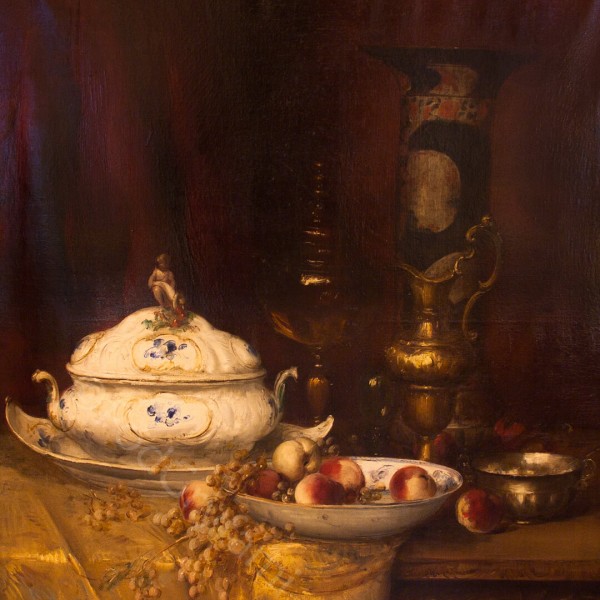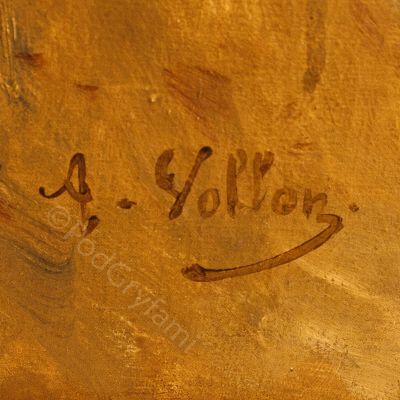Antoin Vollon
Price range: 





 (> 50 000 zł)
(> 50 000 zł)
A work teaming with elegance, extreme realism, that perfectly emphasizes the artist's mastery. In a rather dark room painted with warm browns, a porcelain vase terrina emerges in the foreground. The author, by means of sliding brush movements and the use of several shades of white, seems to emphasize the fragility and thus the elegance of the vessel. Slightly below, in a kind of disorder, partly in bowls, partly on the table are bunches of grapes, tempting with juiciness, accompanied by handsome peaches. In the background we can see a slender, probably enameled vase, almost ethereal glass cups and small, richly ornamented silver dishes. The transition from the darkness of the interior to the snow-white brightness of the vase is softened by a golden stain, a delicate matter covering the table on which the objects are placed. The compactness of the composition, the skillful use of chiaroscuro and the variety of shades of the same colors emphasize the author's inspiration with Flemish painting from the Dutch Golden Age. One of the best works by Vollon, bearing all the features of a museum object. Vollon placed his signature in the lower left corner. The painting and canvas are in good condition and have been well preserved. The piece is well complemented by a richly decorated, perfectly matched frame.
About the artist: Antoin Vollon (1833-1900) A painter of French origin born on 23 April 1833 in Lyon. One of the best realists, known as a still life painter, landscape painter and portrait painter. Master of masters, painter of painters, with an excellent reputation. He came from a craftsman's family. From an early age he showed artistic skills. Initially he started his practice as an engraver and at the same time he started to study graphic arts under Jehan Georges Vibert at the Ecole de Beaux-Arts in Lyon. Then he worked on the decoration of enamel dishes and ovens. In 1859 he moved to Paris where he took up painting in Theodul Ribot's studio. Fascinated by the work of 17th century Dutch masters, he modeled his numerous still lifes on them. During this time he made many excellent friendships. He counted among his friends the likes of Alexandre Dumas, Jean-Baptiste Carpeaux, Honore Daumier and Charles-Francois Daubigny. In 1860, the artist married Marie-Fanny Boucher, with whom he had two children, daughter Marguerite and son Alexis (1865-1945). His son inherited talent from his father and soon became a recognized painter himself. From 1864 Vollon exhibited his works at the Salon de Paris (one of the most valued art exhibitions held since 1725, between 1748 and 1890 recognized as the largest annual or biennial official event in the Western art world), where he won numerous awards and distinctions, including medals: third, second and first class in 1865, 1868 and 1869, and first prize in 1870. In any case, the year was particularly gracious for Vallon. The artist was appreciated not only as a painter, but also as an official member of the jury of the Salon de Paris, which he remained for the next ten years, and was nominated as an Officer of the Legion of Honour. Then, in 1878, he was awarded the Officer's Cross. In 1897 he was honoured at the Academie des Beaux-Arts. and in 1900 he received the Grand Prix at the Paris World Fair. Unfortunately, in the same year while painting at Versailles, Vollon had a stroke followed by complications and on August 27th the artist died. He was buried in the Pere Lachaise cemetery. During his lifetime, the artist gained great recognition, critics wrote: ... Vollon is probably the most outstanding living painter. His works can still be admired in numerous museums in France, Holland, Sweden, Russia and even the United States.
Details
| Title: | "Still life with vase and peaches" |
| Medium: | Oil on canvas |
| Width: | 102 cm |
| Height: | 112 cm |




